Derby County compete in the 2024/25 EFL Championship after having been promoted from League One, where they played for the previous two seasons.
Although only four matches have been played, which is relatively early to make a definitive assessment, Derby County’s start to the season has been balanced so far; they currently occupy 10th place with six points, having secured two wins and suffered two defeats.
Defensively, Derby County’s statistics are average, having conceded six goals.
This places them in a mid-range position compared to other teams, with Sunderland having the strongest defence by allowing only one goal and Cardiff City having the weakest defence, having conceded 10 goals.
Offensively, their performance is stronger, as they have scored seven goals, only three fewer than Sunderland, who have the most potent attack.
Remarkably, they have scored five of their seven goals from set-pieces, accounting for approximately 71% of their total goals.
In this tactical analysis, we will examine their distinctive and innovative tactics in set-pieces, particularly focusing on corners and throw-ins where they employ a variety of movements before execution, each serving different purposes.
Derby County Corners Set Piece Analysis
Starting with corners, they have three main axes on which they depend in their routines, all related to the starting positions and state.
These three main ideas are traffic in front of the goalkeeper, far starting positions and circular movements.
Traffic In Front Of The Goalkeeper
In the photo below, the opponent defends with two zonal defenders, a short-option defender, a rebound defender and six man markers.
Paul Warne’s side attacks the box with six attackers, five between the two zonal defenders, while the sixth stands after the far post.
They also have a short-option attacker, and two players stay at the back for counterattacks, out of the shot.
Their general idea of this pack in front of the goalkeeper is to make him unable to move freely to clear the goal.
They also move in different directions, distracting the man markers while evacuating this area, which will be underloaded.
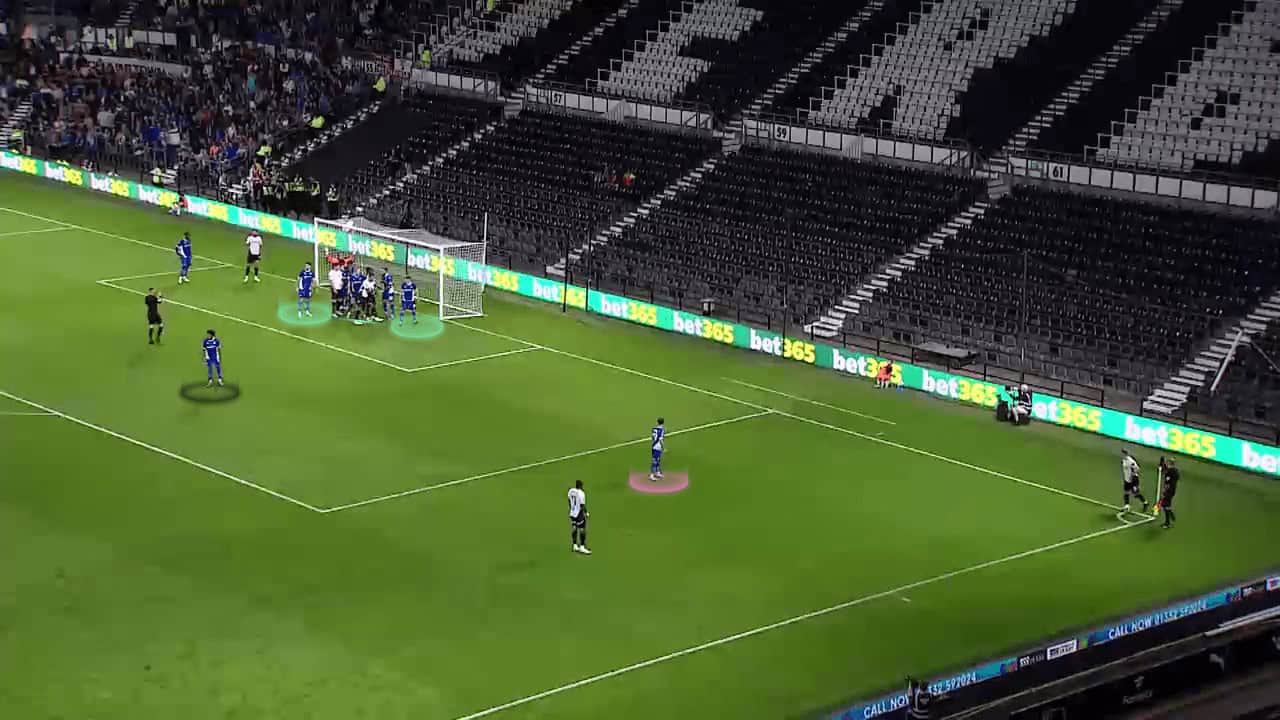
Let’s track the movements of these six attackers!
Two attackers, numbered in blue, evacuate that area, stepping back towards the far post, while the yellow attacker, who was initially on the far post, will move in front of the second zonal defender.
The orange attacker leaves that pack going forward to drag the first zonal defender a few steps forward, making the targeted underloaded area empty for the only one left there besides the one who blocks the goalkeeper, as in the second photo below.
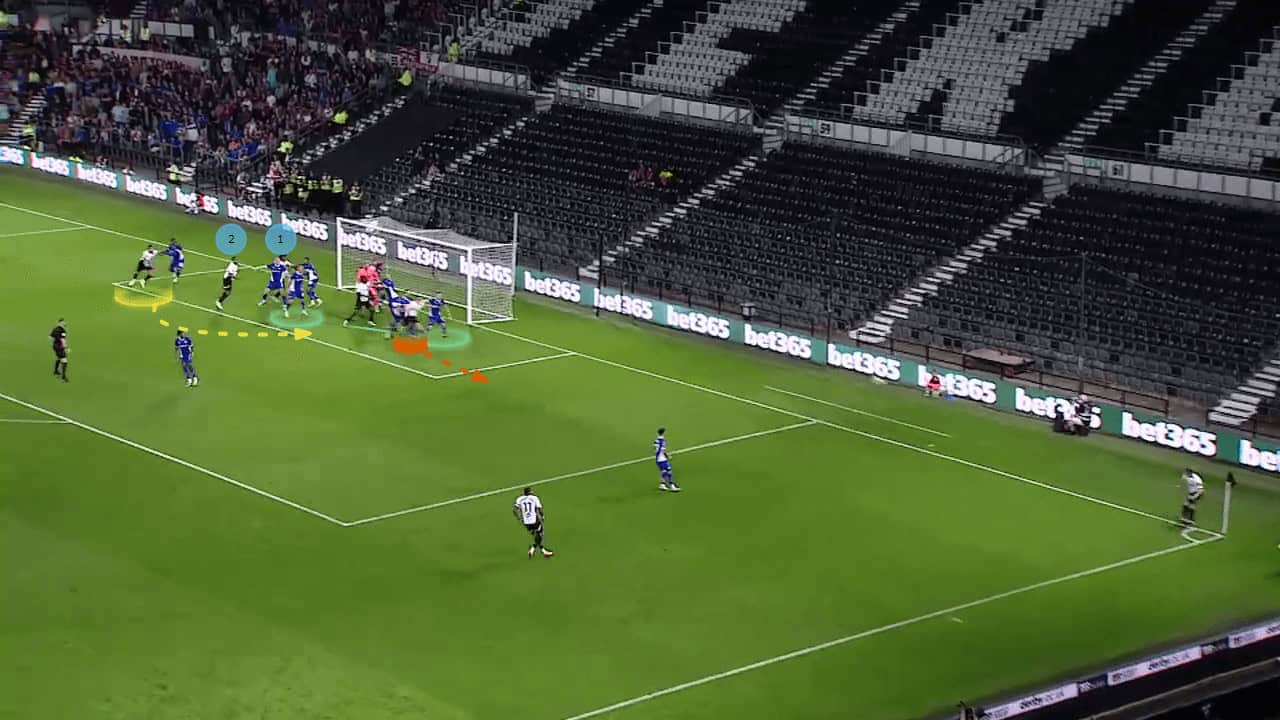
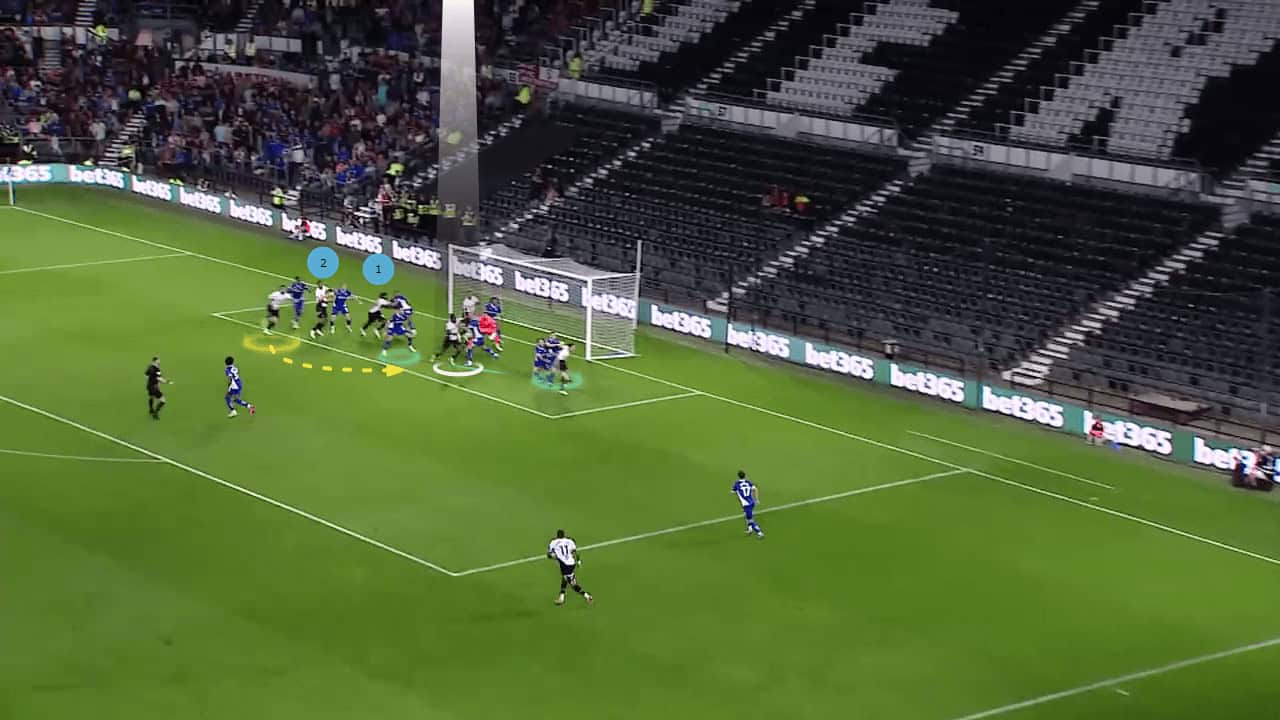
The plan works, so the targeted player hits the ball, and it ends with a goal after many touches thanks to the crowded number of attackers in the six-yard area who frame the goal and stand on the near, middle, and far posts.
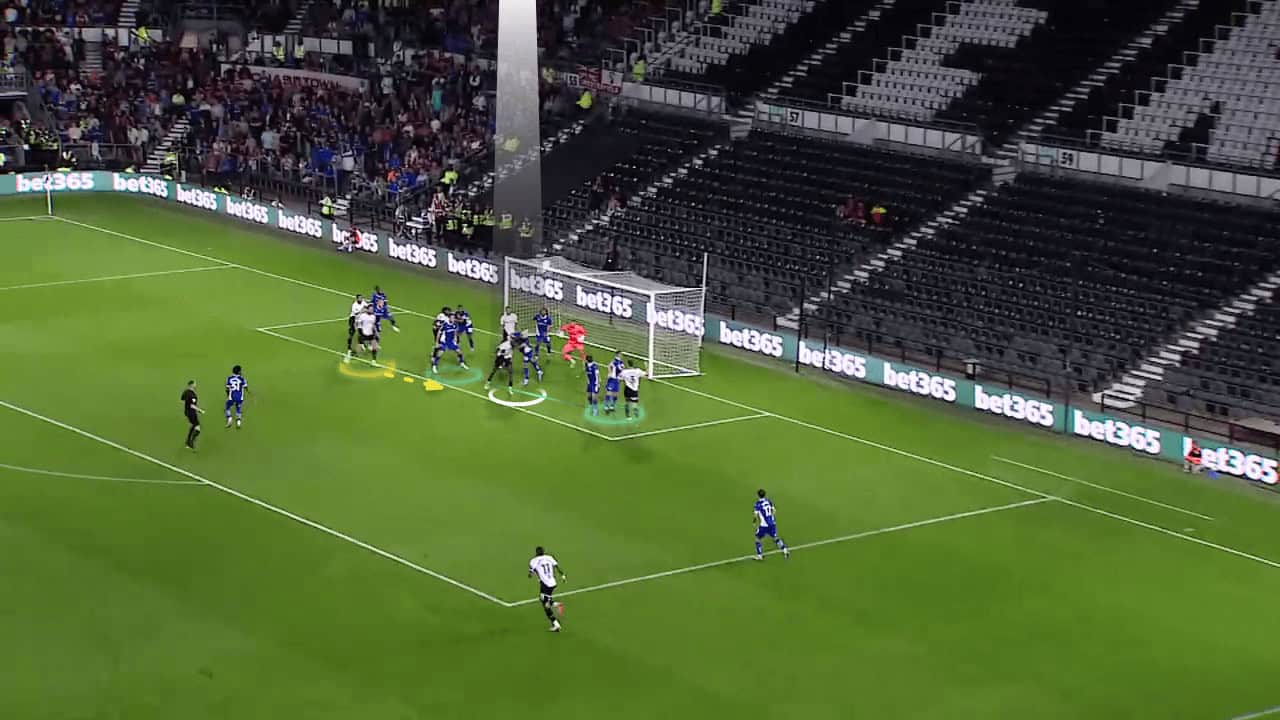
Far Starting Positions
In the case below, we see the same defensive scheme, but Derby County has five attackers starting outside the box, leaving only one attacker to stand in front of the goalkeeper, preventing him from claiming the ball.
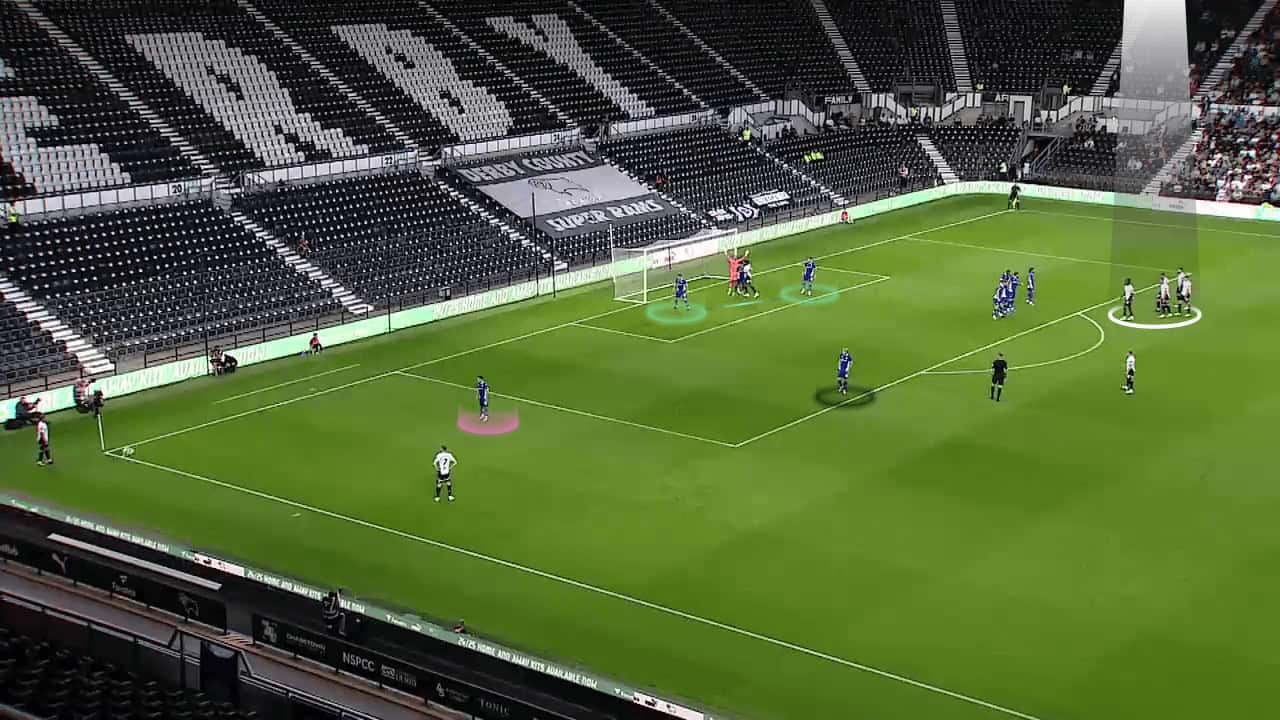
This far starting position enables the attackers to run before facing the defender, who waits for him.
This separation between them allows the attackers to achieve a dynamic mismatch over the defender.
This is supported by another problem, which is an orientation problem for the marker, who faces difficulty tracking both the attacker and the ball at the same time without opening the direct path to the goalmouth, as happens in yellow below.
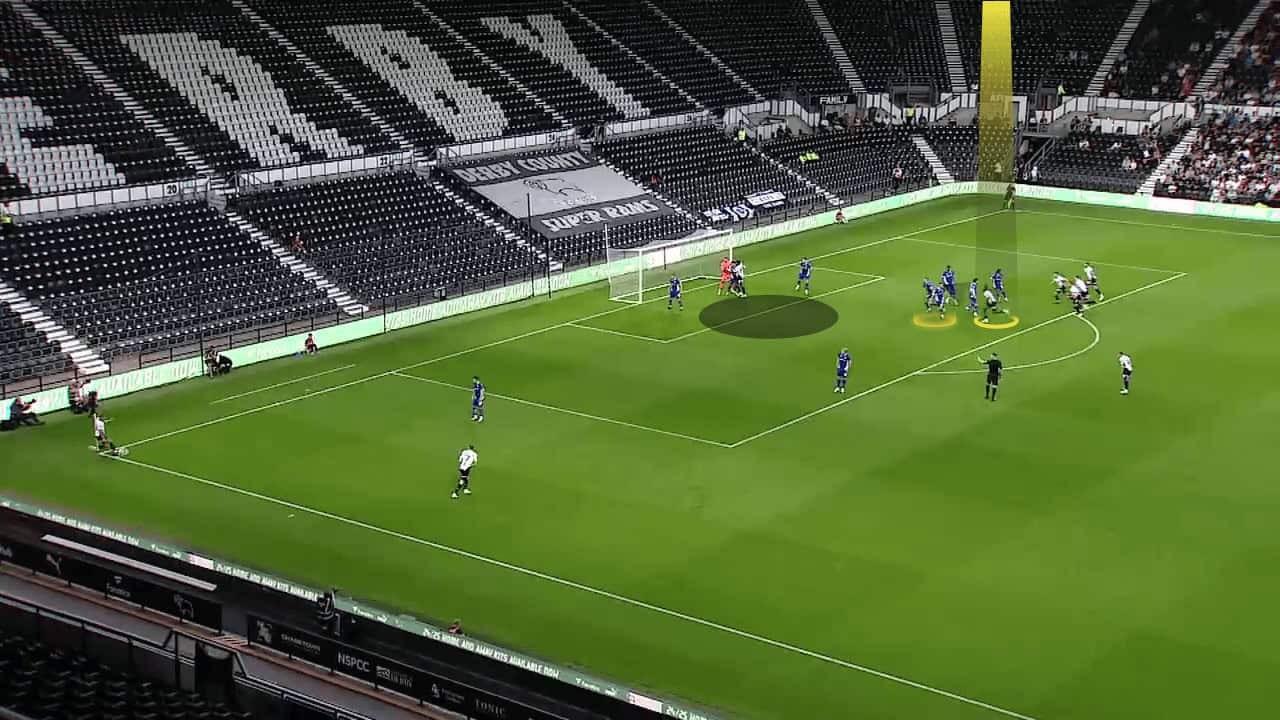
This opens the direct path to the targeted area for the targeted player, as shown below.
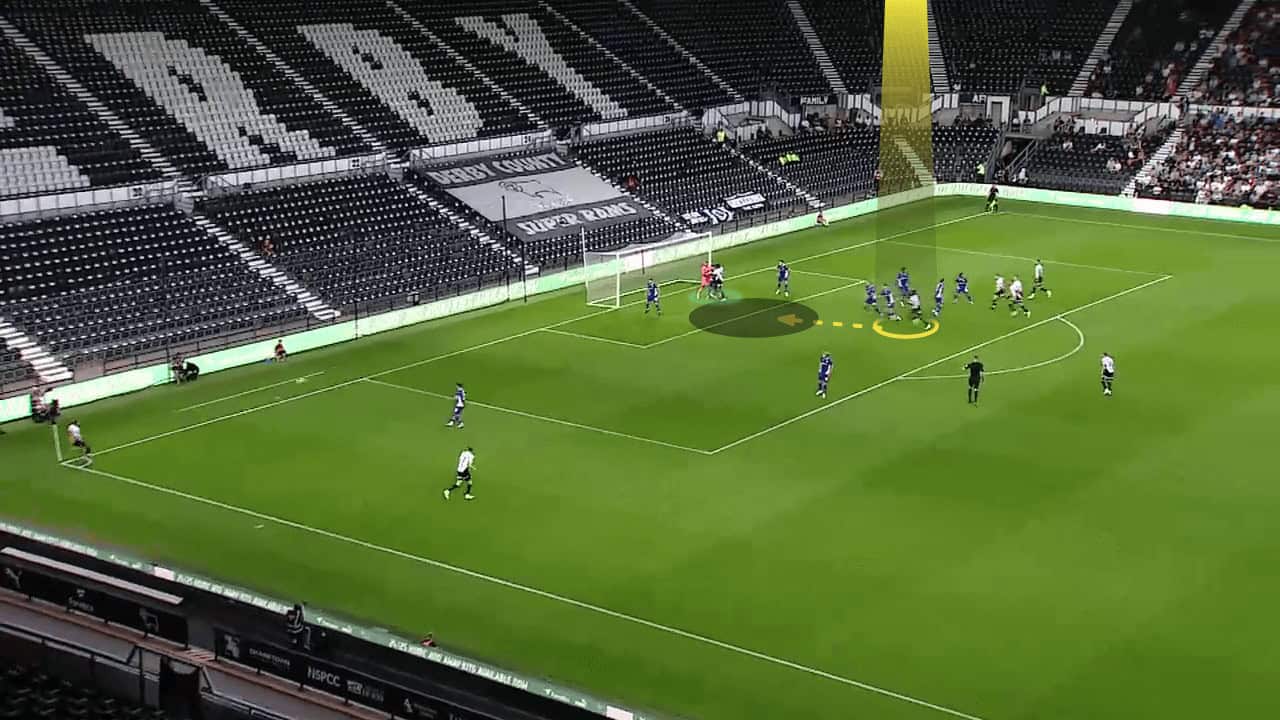
The plan works, but the cross is near the first zonal defender, who takes a step to chase the ball, as shown below.
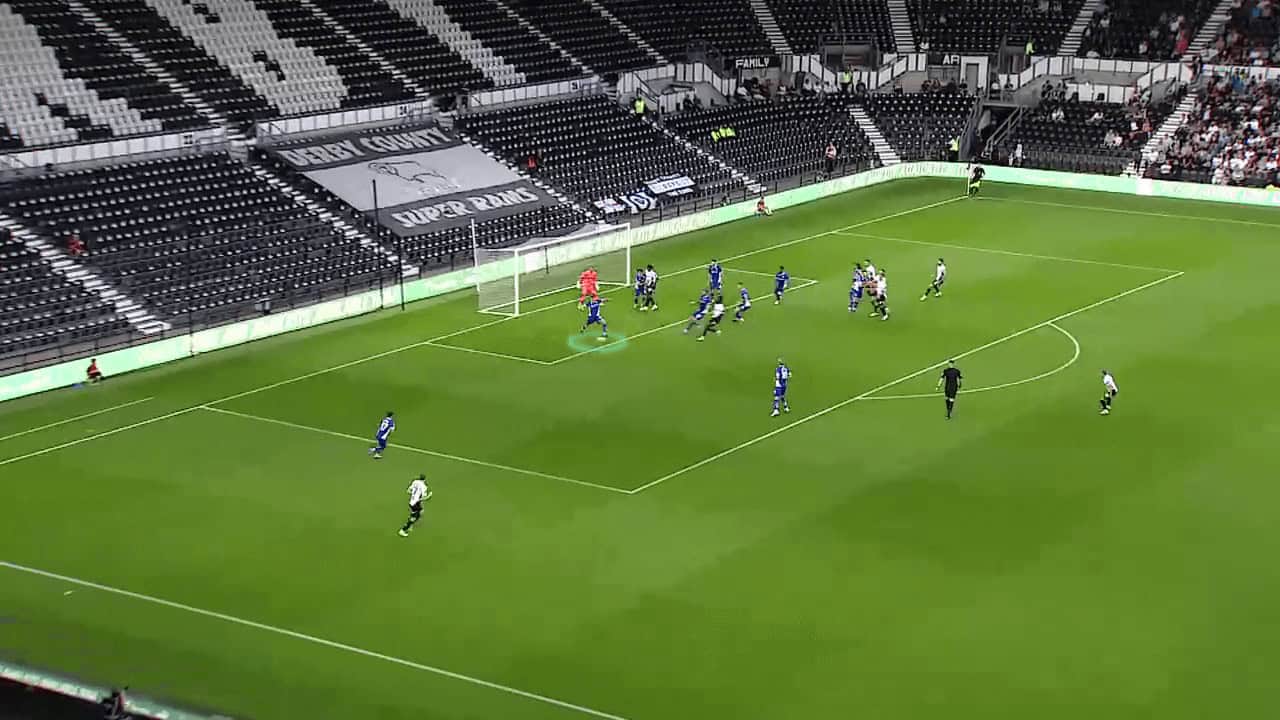
Circular Movements
They have a unique way of asking the attackers to start around the penalty spot in a circular shape and then keep turning around in a circular path to distract the man markers’ attention from the real targeted player who moves suddenly at the right time.
Let’s explain below that in detail!
Starting with the defensive scheme as usual, the opponent defends with four players in the first zonal line, two players in the second zonal line, three orange man markers and a short-option defender.
First of all, they assign a player as a short-option defender as an illusion to drag the first zonal defender a few steps forward to be ready to help in the short corner.
After that, they want to free the targeted player, in yellow, so the five runners start moving circularly around themselves, not to show their intentions with the right timing and the real targeted player.
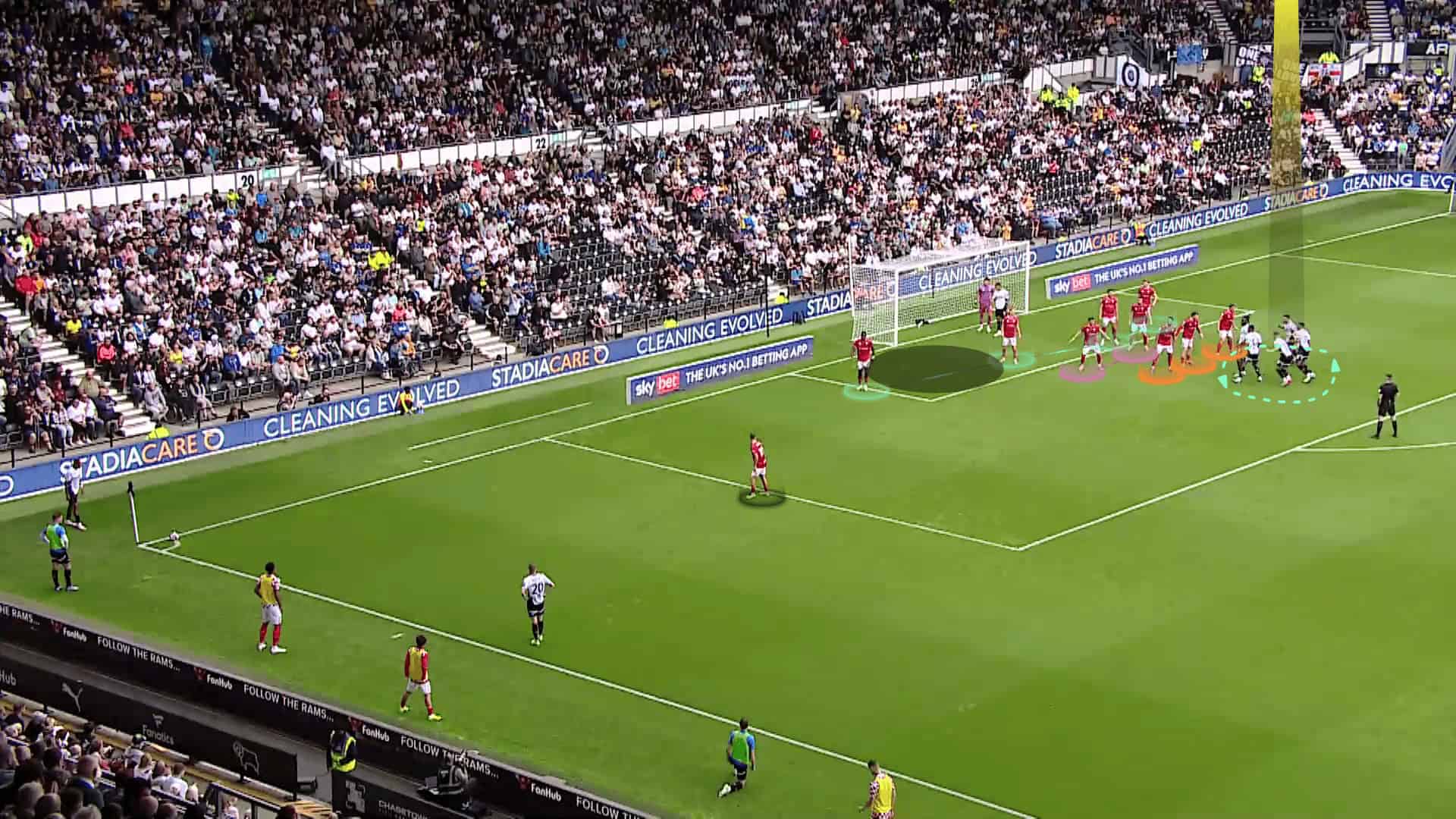
When the taker raises his hand, it is a sign for the targeted player to start moving suddenly to the targeted area while the man markers are shocked and still tracking the rest of the attackers’ movements, as shown in the two photos below.
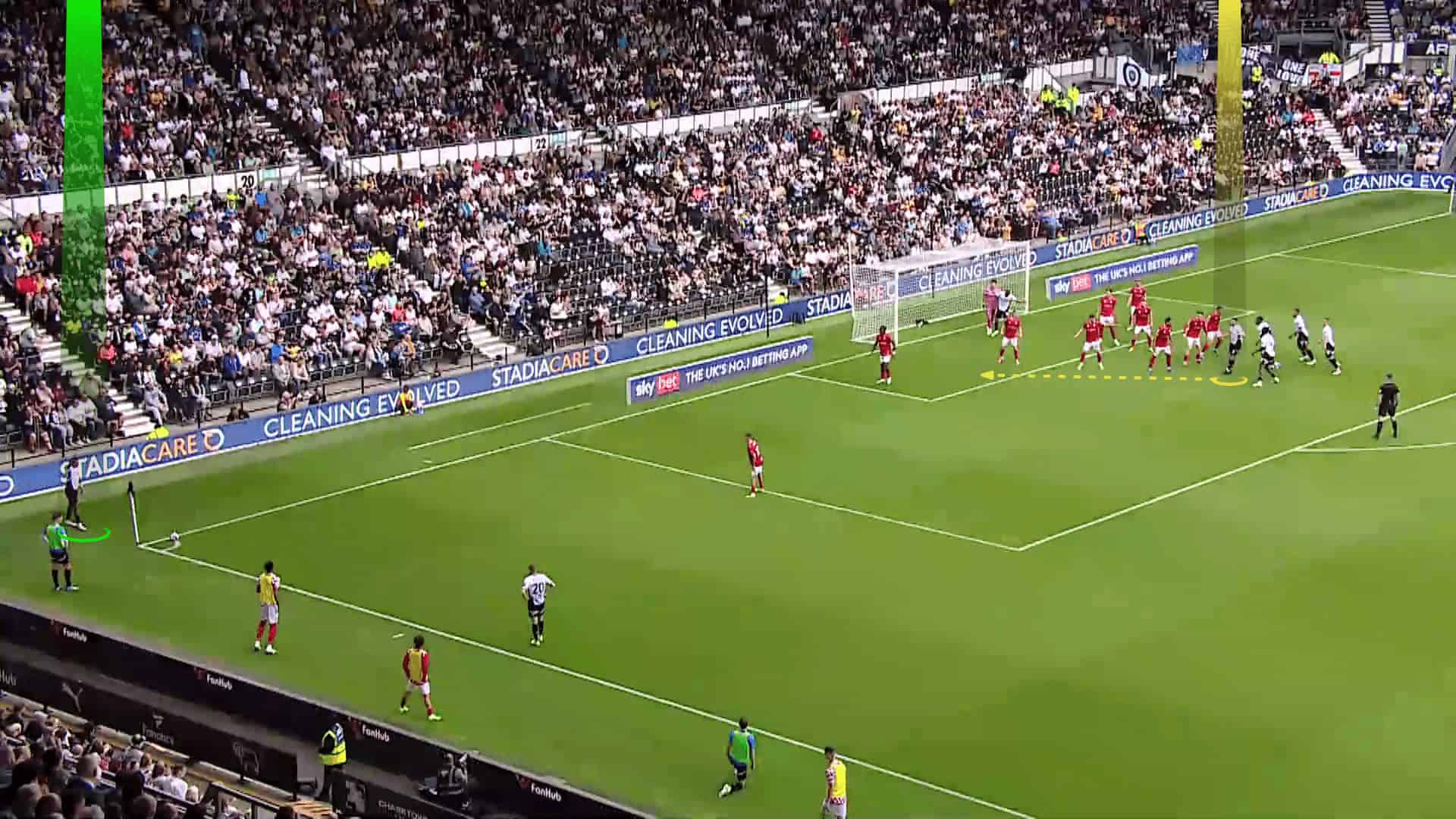
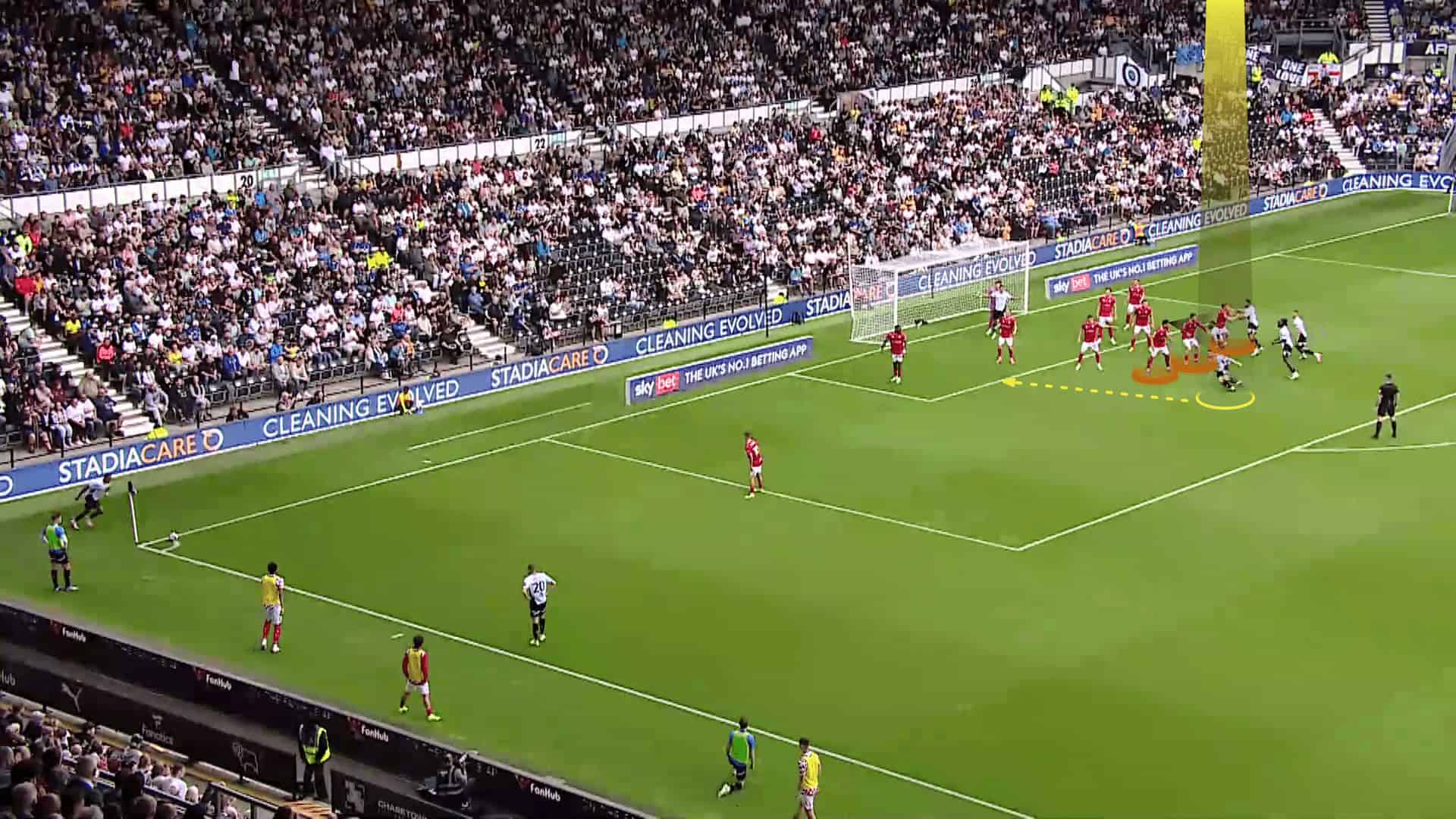
The plan works, but the second zonal defender shifts to cover this gap, so we suggest blocking that zonal defender for a better result.
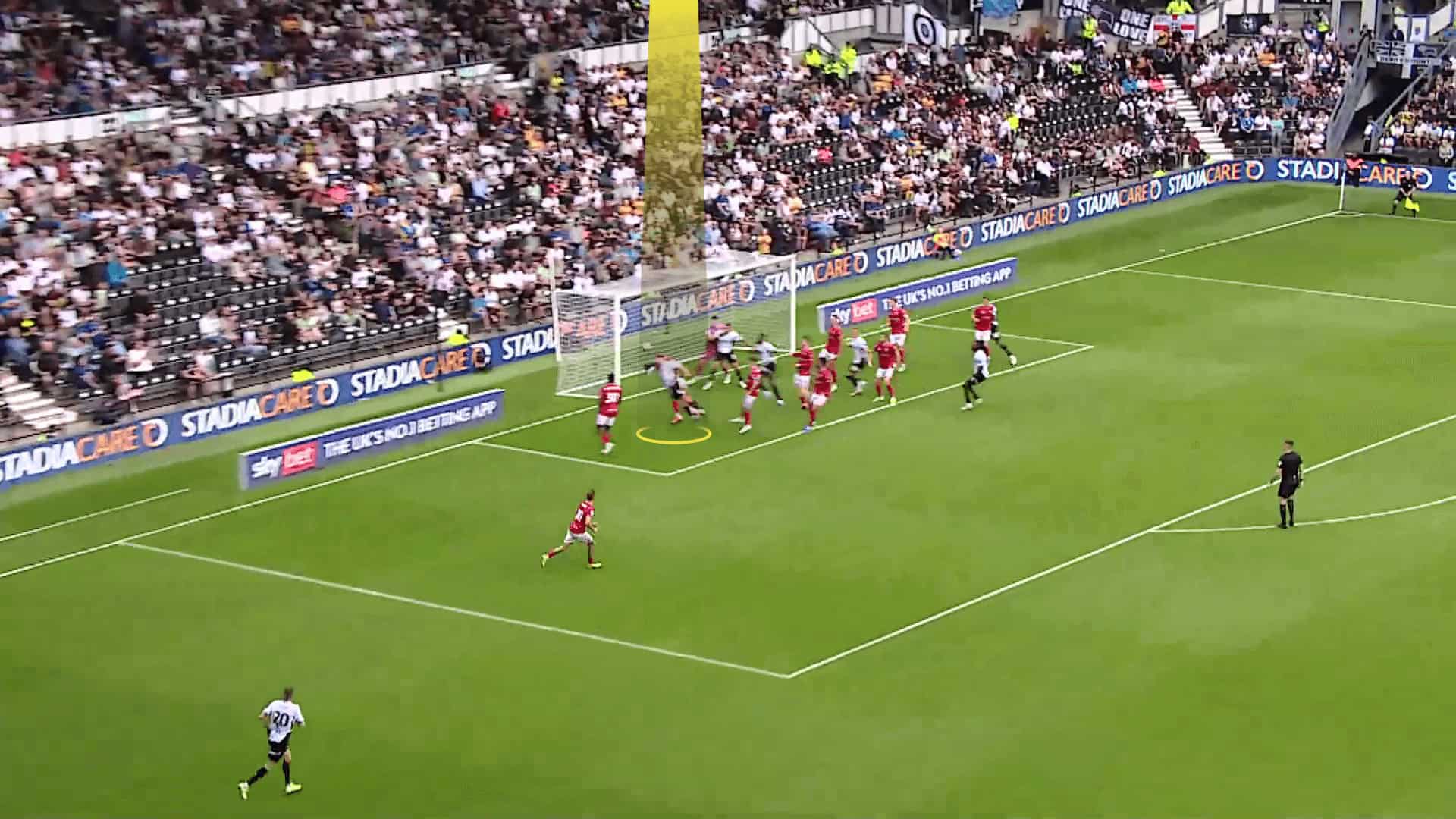
Derby County Throw-Ins Set-Piece Analysis
As we have mentioned, they are using a similar concept of pre-movements in throw-ins but with some changes.
We will also explain the three main ideas they exploit in throw-ins, especially in the final third: wall pass, third-man pass, and switches beside a third-man pass.
Wall Pass
Let’s take it step by step, starting with the defensive shape during their throw-ins in the final third.
Most of their opponents stand deeply in the normal low block with a man-marking responsibility for any defender to follow the opposition attacker who tries to get nearer to receive the ball, so you can find below the opponent defend with the normal 4-2-3-1 shape, the striker is out of the shot.
On the other hand, Derby County also follow the same 4-2-3-1 formation with slight instructions for the striker and the two wingers to get closer to the box, dragging the defenders away from the taker.
At the same time, the midfielder near the ball suddenly moves toward the taker, as shown below.
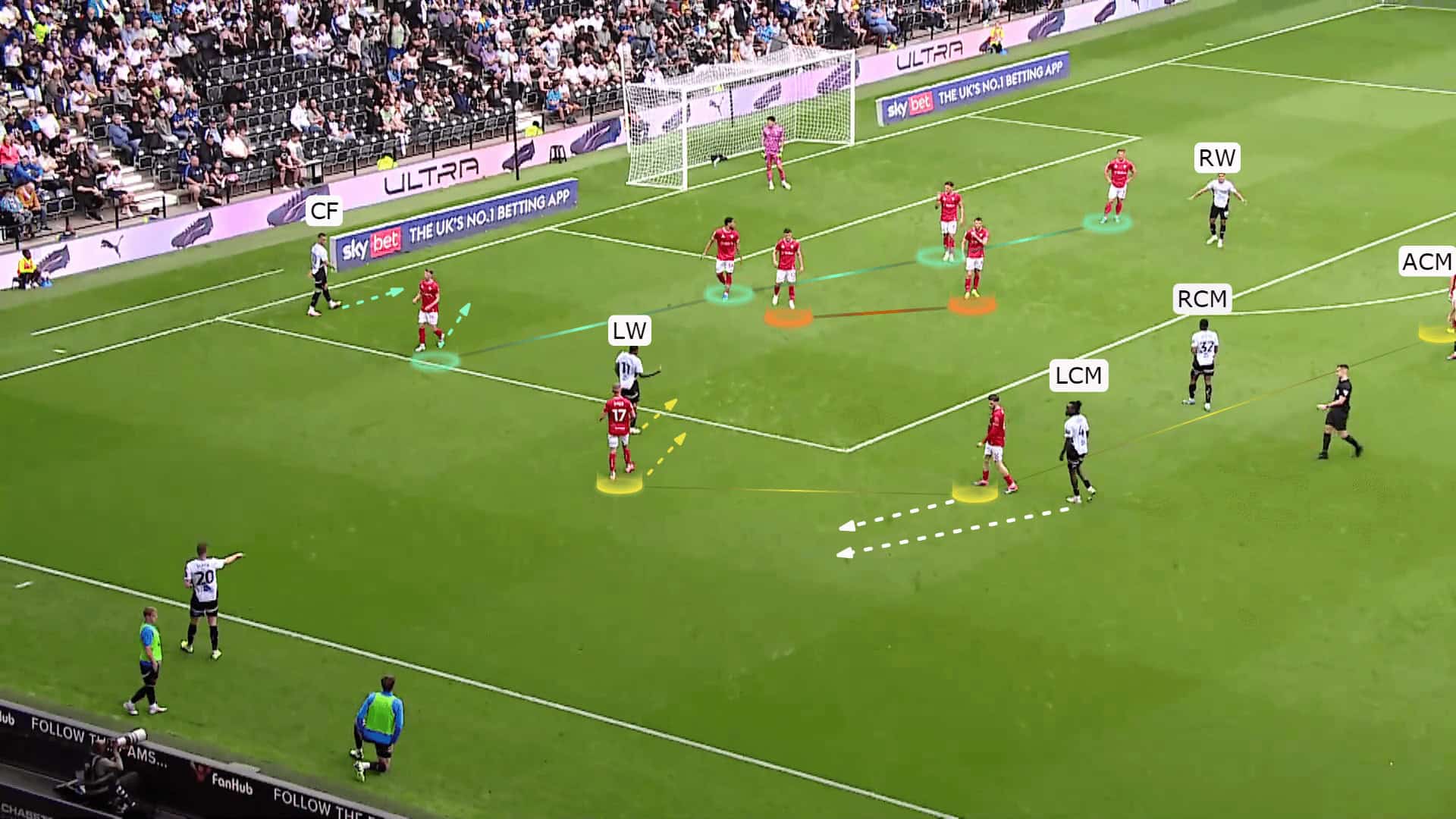
The midfielder just passes the ball back to the taker, and you may wonder about the problem, saying that you have seen this action so many times.
The issue is that the situation becomes a 2-v-1 situation once the taker joins the game in this empty area, which has been evacuated, so the taker can receive the ball, dribble, and cross from a dangerous point.
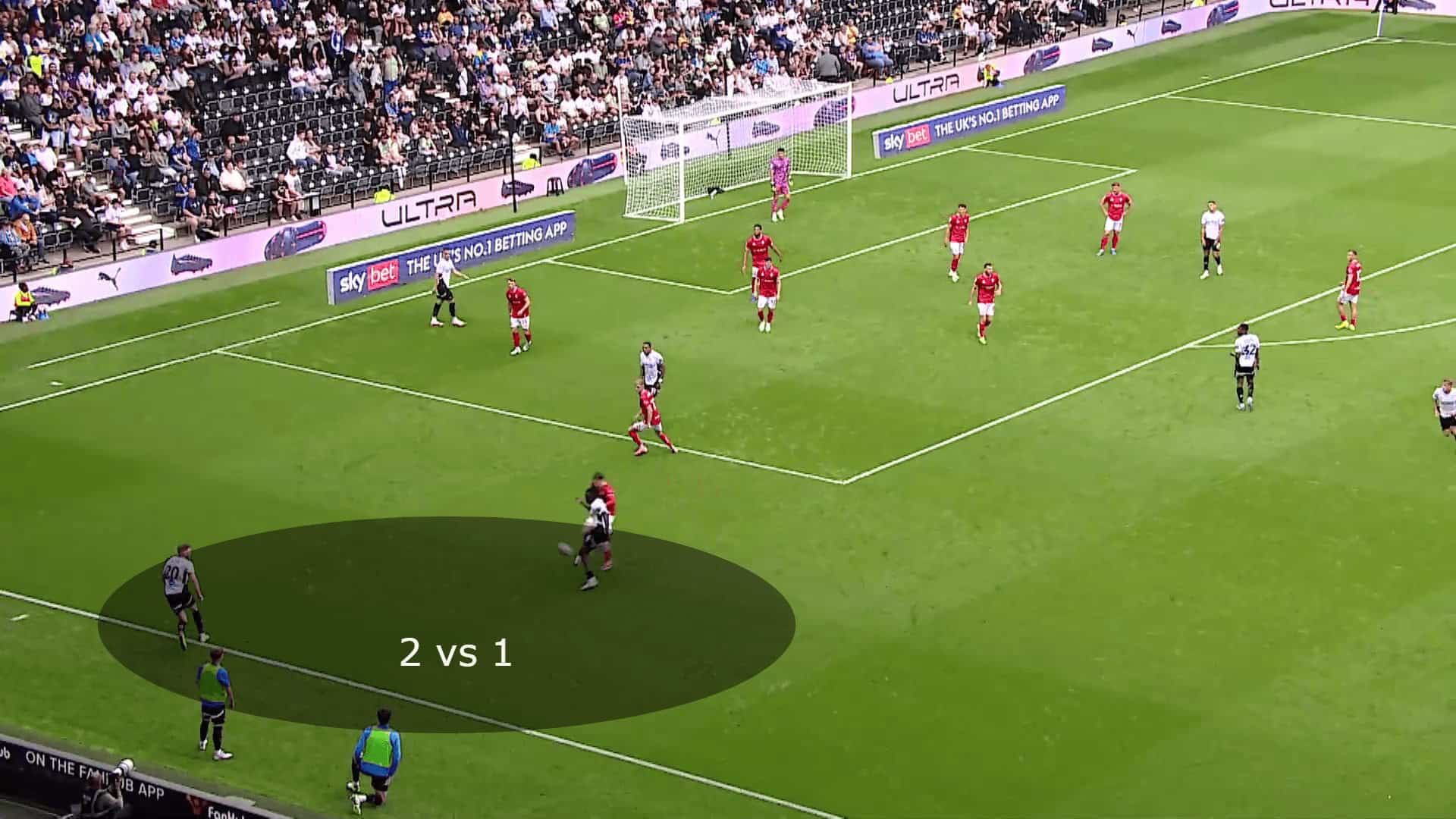
They do this trick in many forms to hide the intentions of the player who suddenly moves towards the taker and to evacuate the area between the taker and the edge of the box, as shown below.
The opponent below defends with a 5-2-2-1 shape, while Derby County is in the same 4-2-3-1 shape using a similar principle but with an additional trick.
The 10th is asked to start inside the box, giving his back to the taker, pretending that he doesn’t care, and then suddenly turning around.
At the same time, the right winger goes to block his man, as called a screen, as shown in the two photos below.
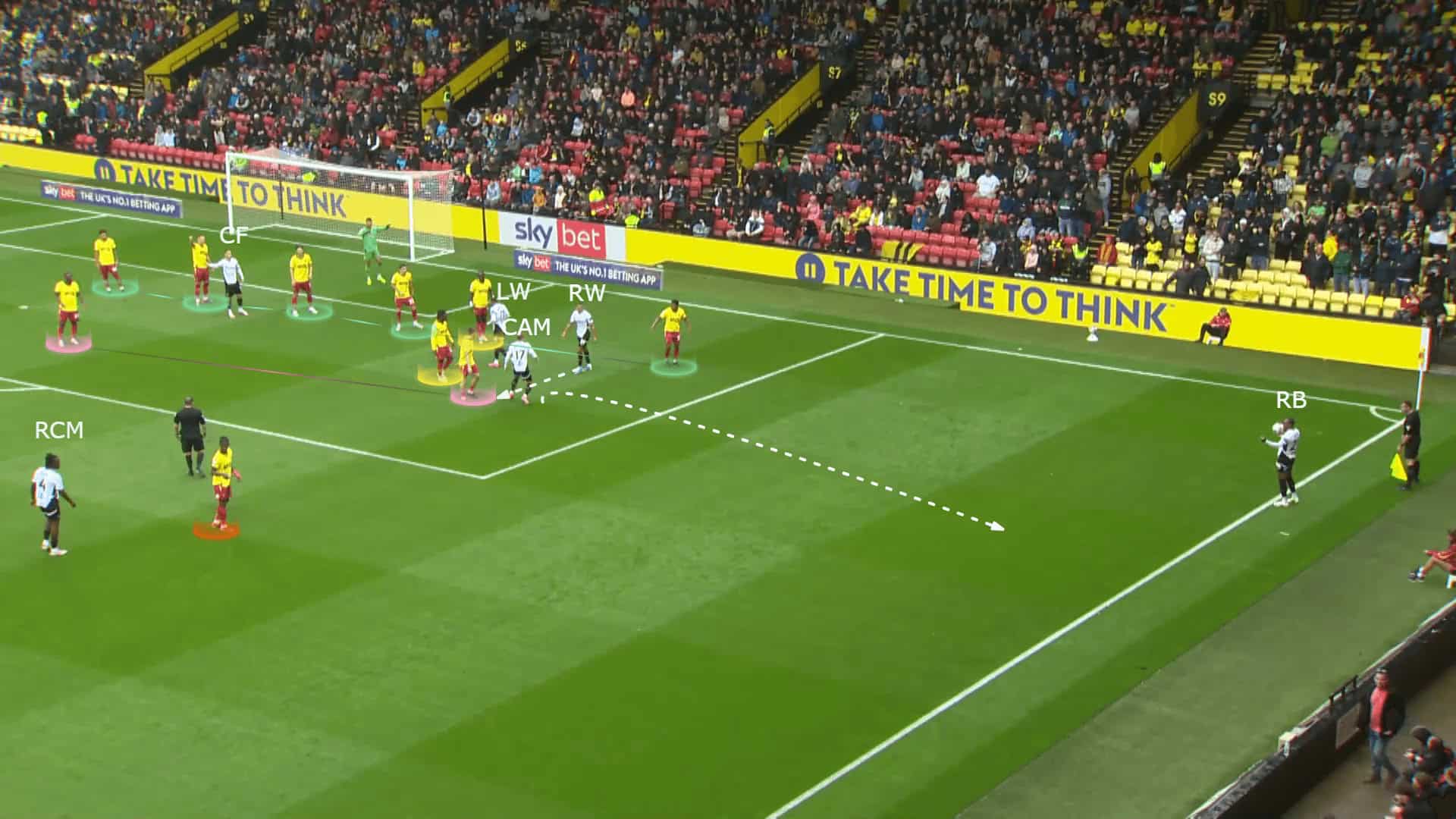
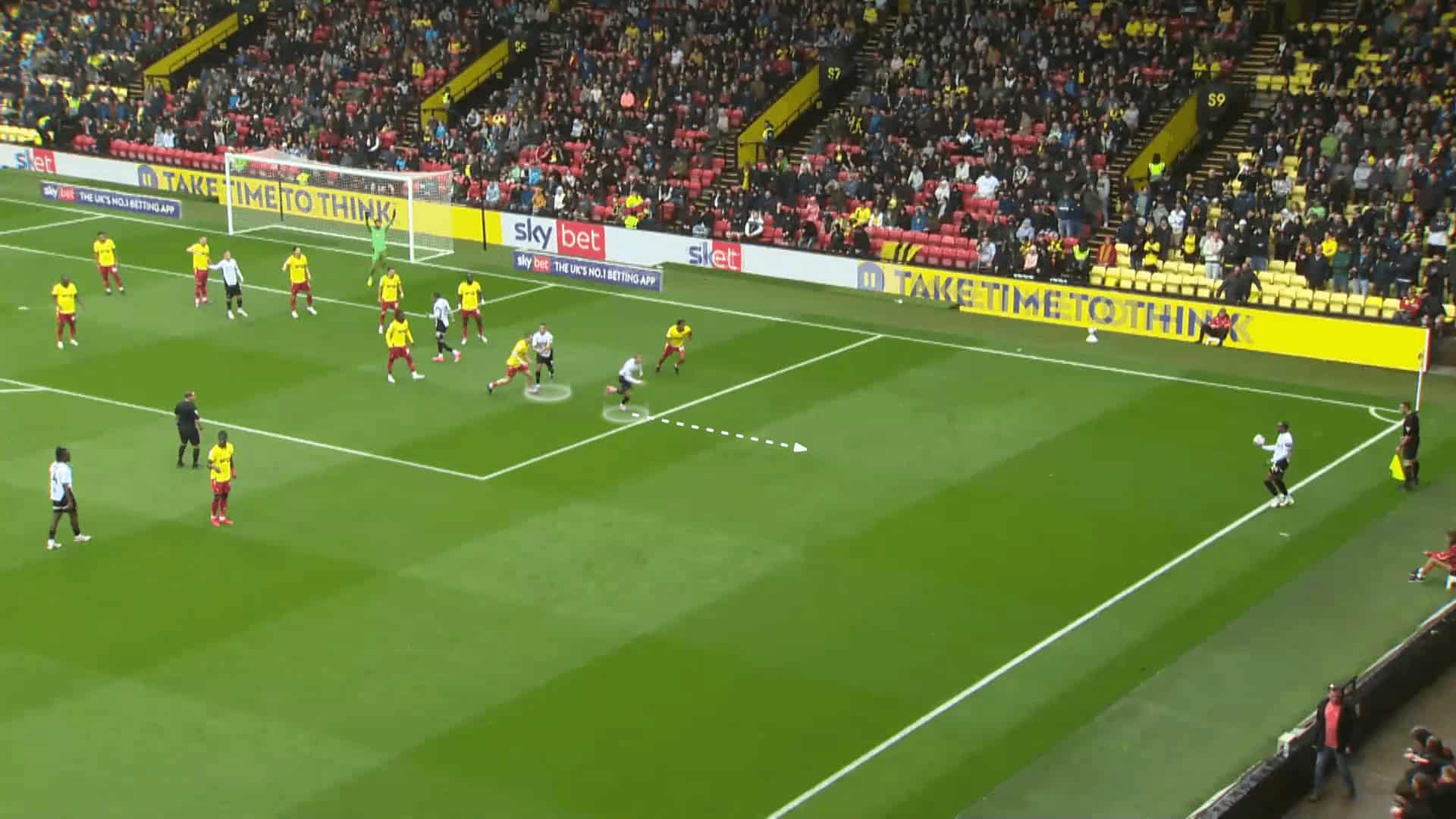
The same principle appears in the photo below, and it becomes a 3-v-2 situation by the right winger’s joining, who runs into the empty evacuated space, as shown in the two photos below.
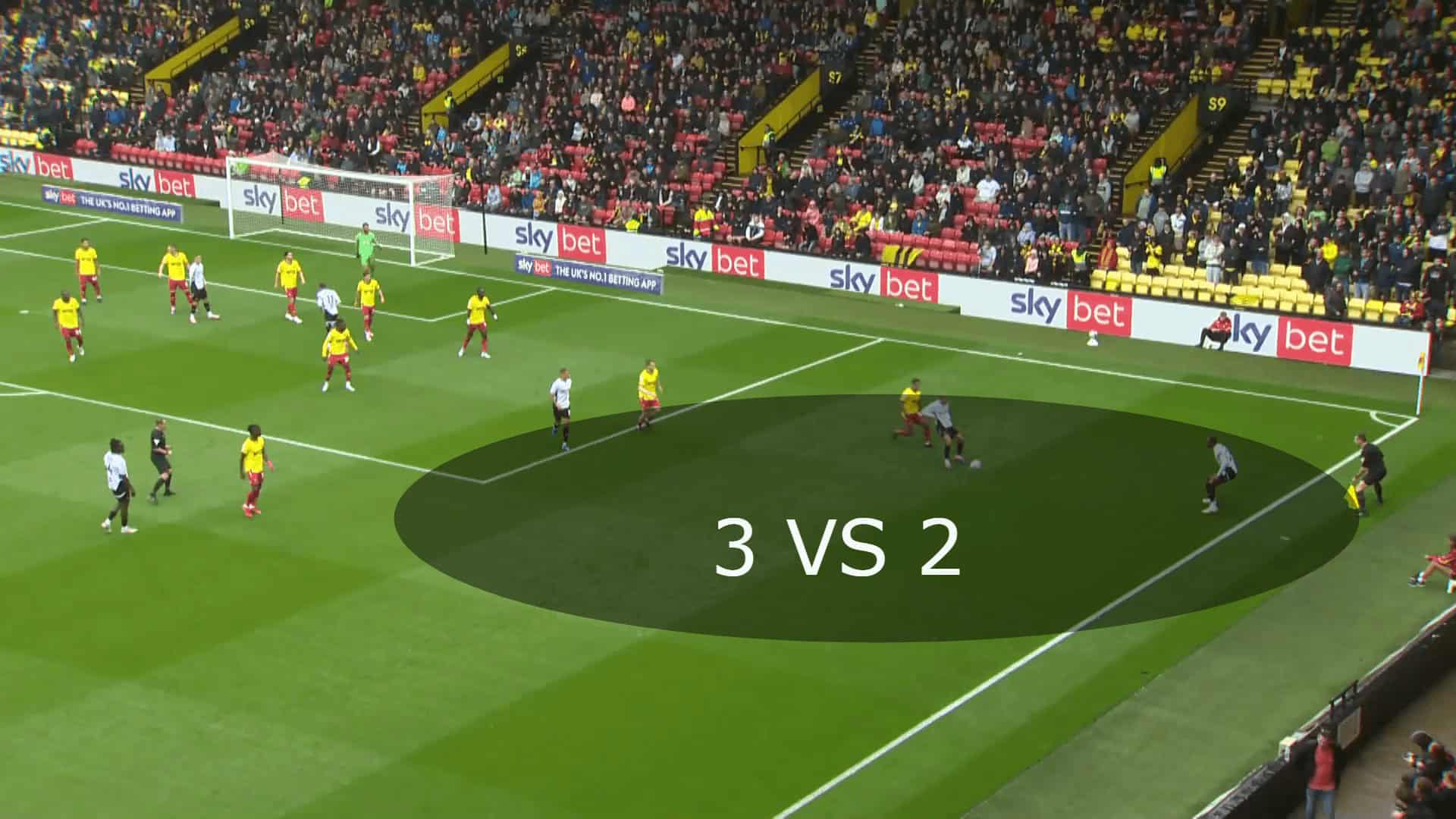
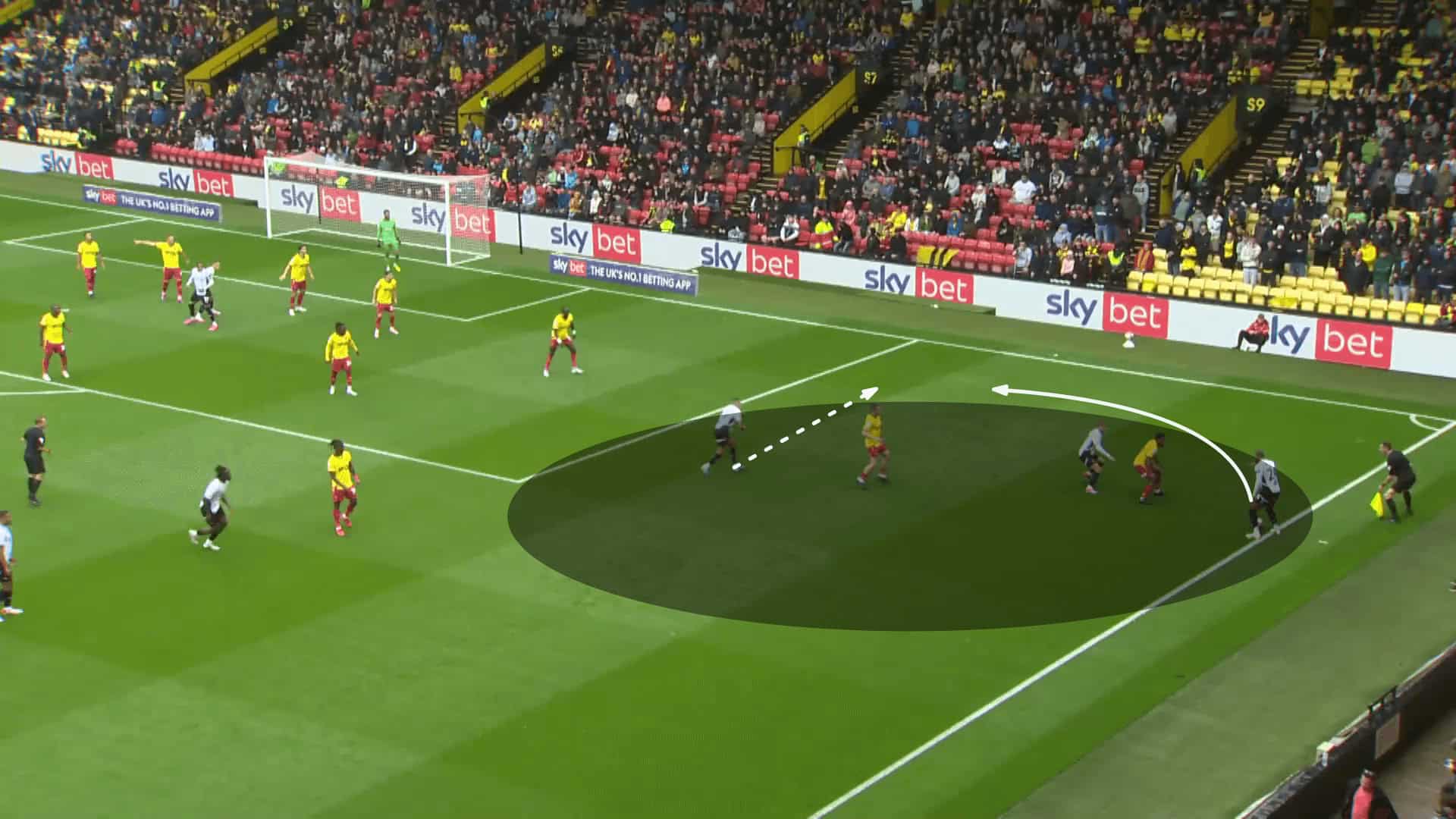
The plan works, so he plays a direct pass to the edge of the box, where the left midfielder and the left full-back stand out of the shot.
The first one scores a goal.
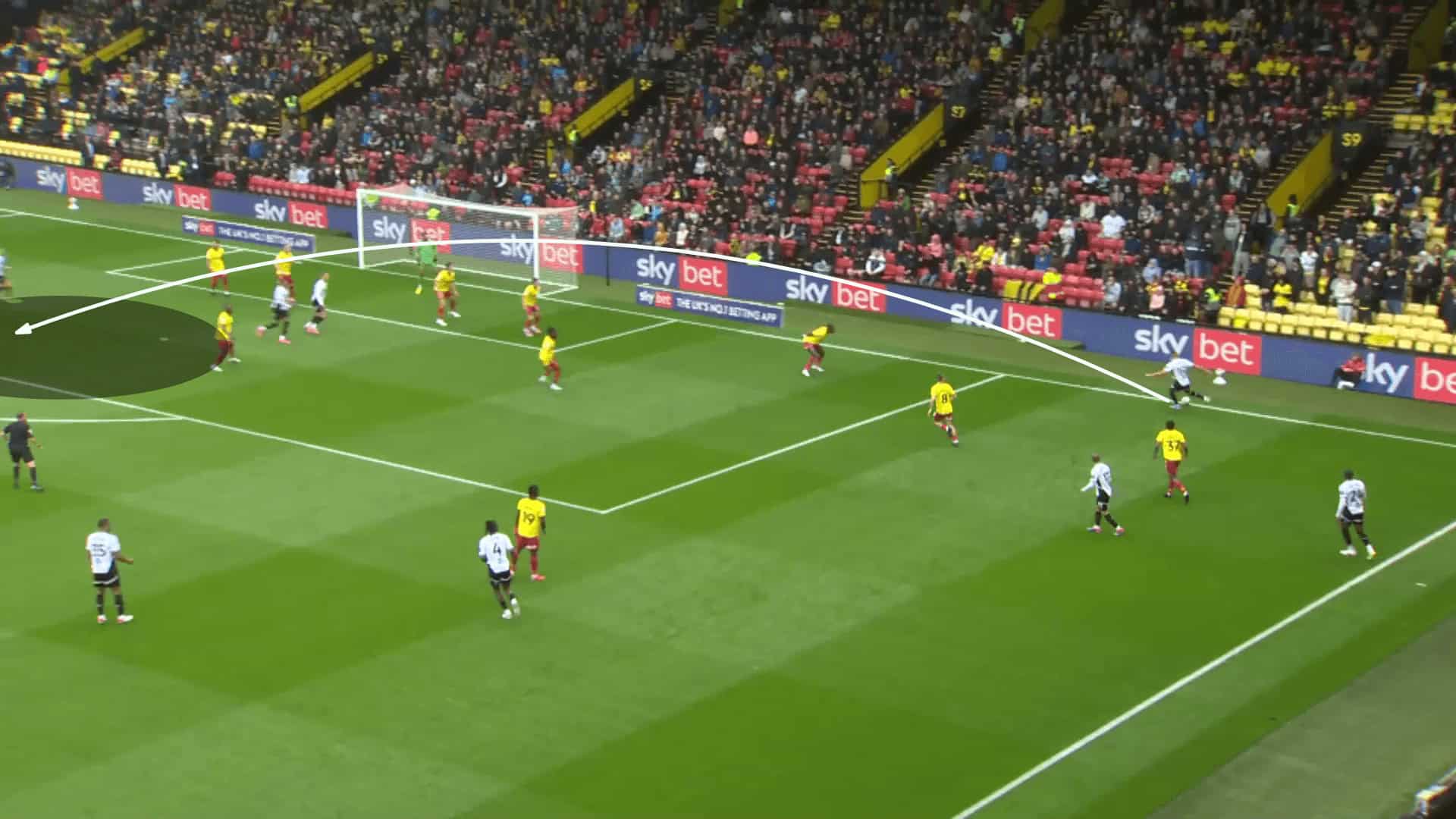
Third-Man Pass
Against the same team and defensive formation, they have another plan to evacuate another area, this time inside the box.
The right midfielder gets nearer to the taker, dragging the opponent’s left wing-back and the left winger, who stands as an additional player ready for the previous scenario.
This time, the ball is played directly to the right winger inside the box, who will do a third-man pass to the right midfielder, who comes suddenly, exploiting the defenders’ concentration on the ball as the normal third-man run in open play.
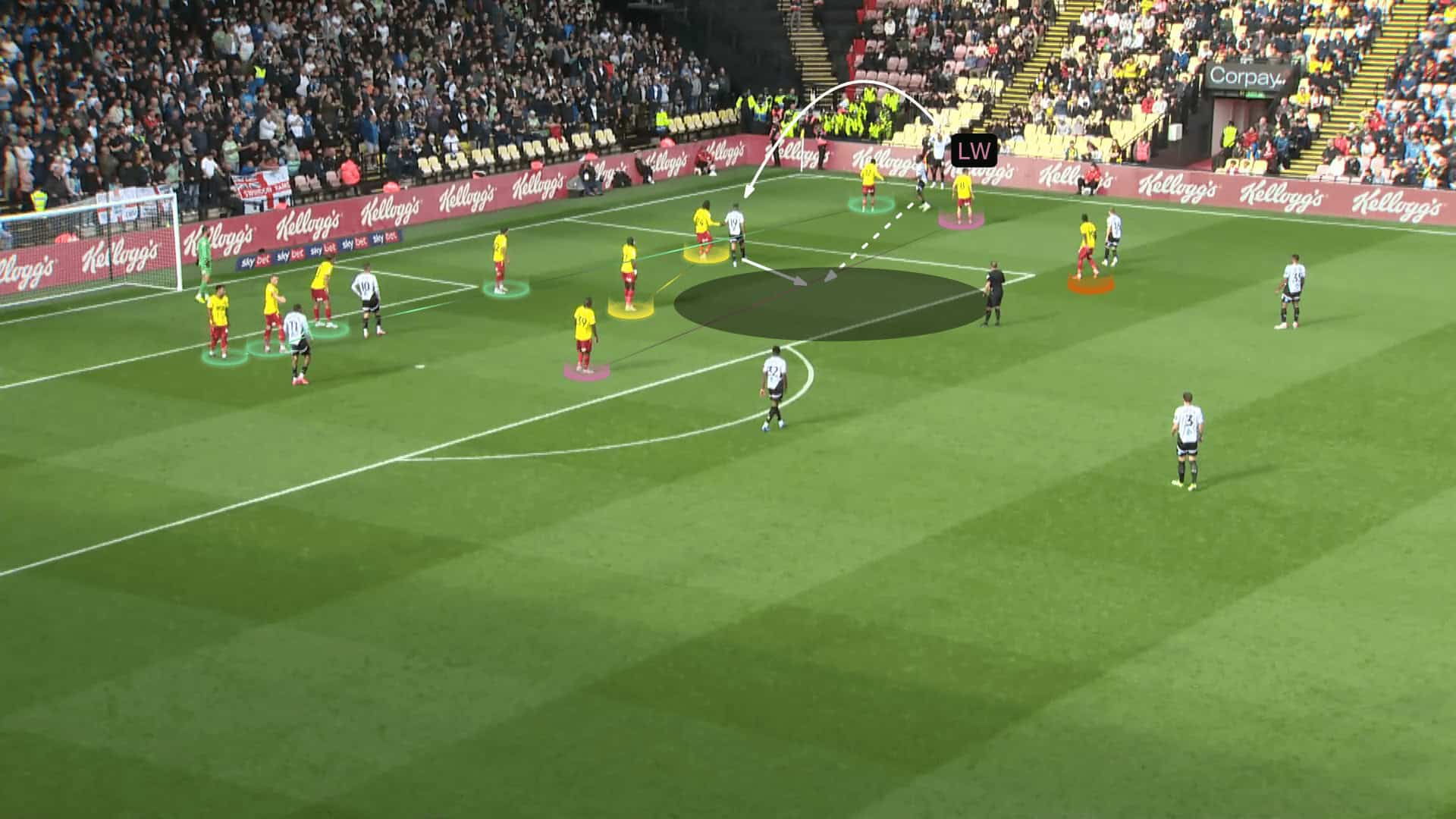
The plan works, so he receives the ball at a dangerous point, but he can’t control the ball well.
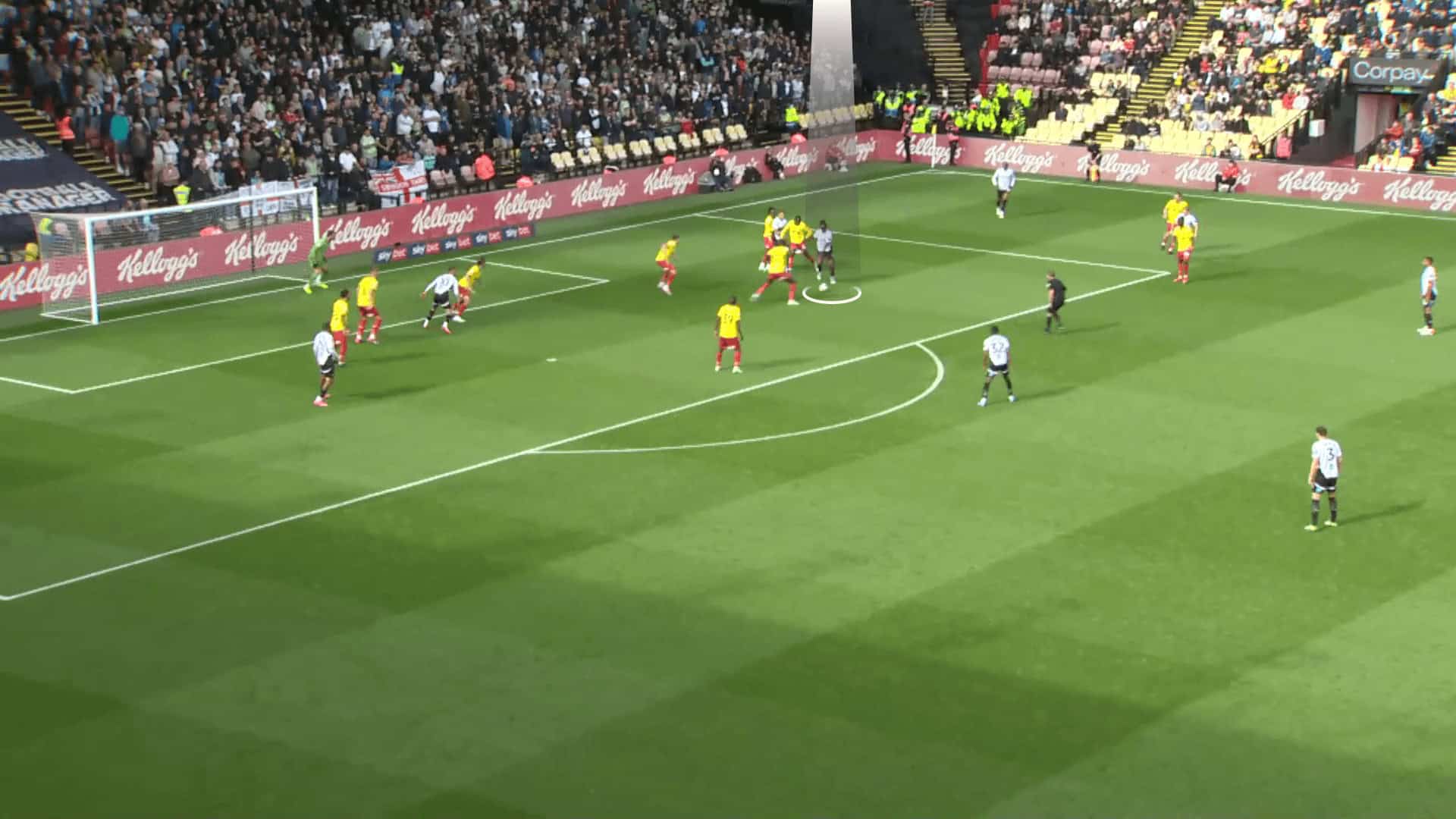
Switches & Third-Man Pass
In a combined idea, they add switches to the third-man pass to further distract the defenders.
Using switches confuses the markers, which may delay their reactions.
The opponent stands in a 4-4-2 shape, dealing with a man-marking orientation, while the left midfielder and the left winger start to make the first switch without a purpose except to sow down the defenders’ reaction after that when the time comes to the right timing of the important switch, as we will clarify.
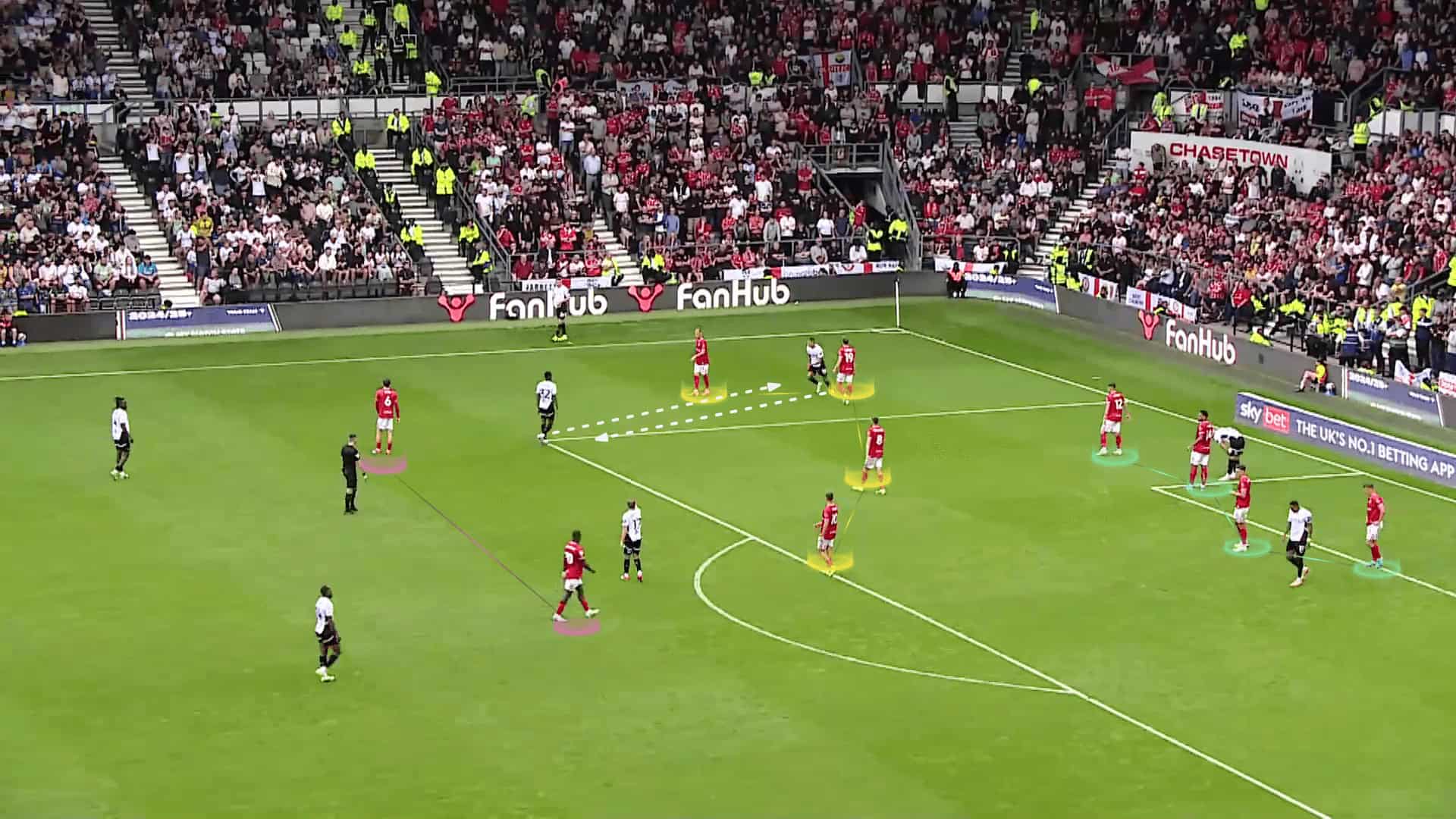
This time, the second switch is critical because the striker, exploiting the fact that there is no offside in throw-ins, moves suddenly forward to receive the ball and makes a third-man pass toward the free attacker due to the switch, as shown below.
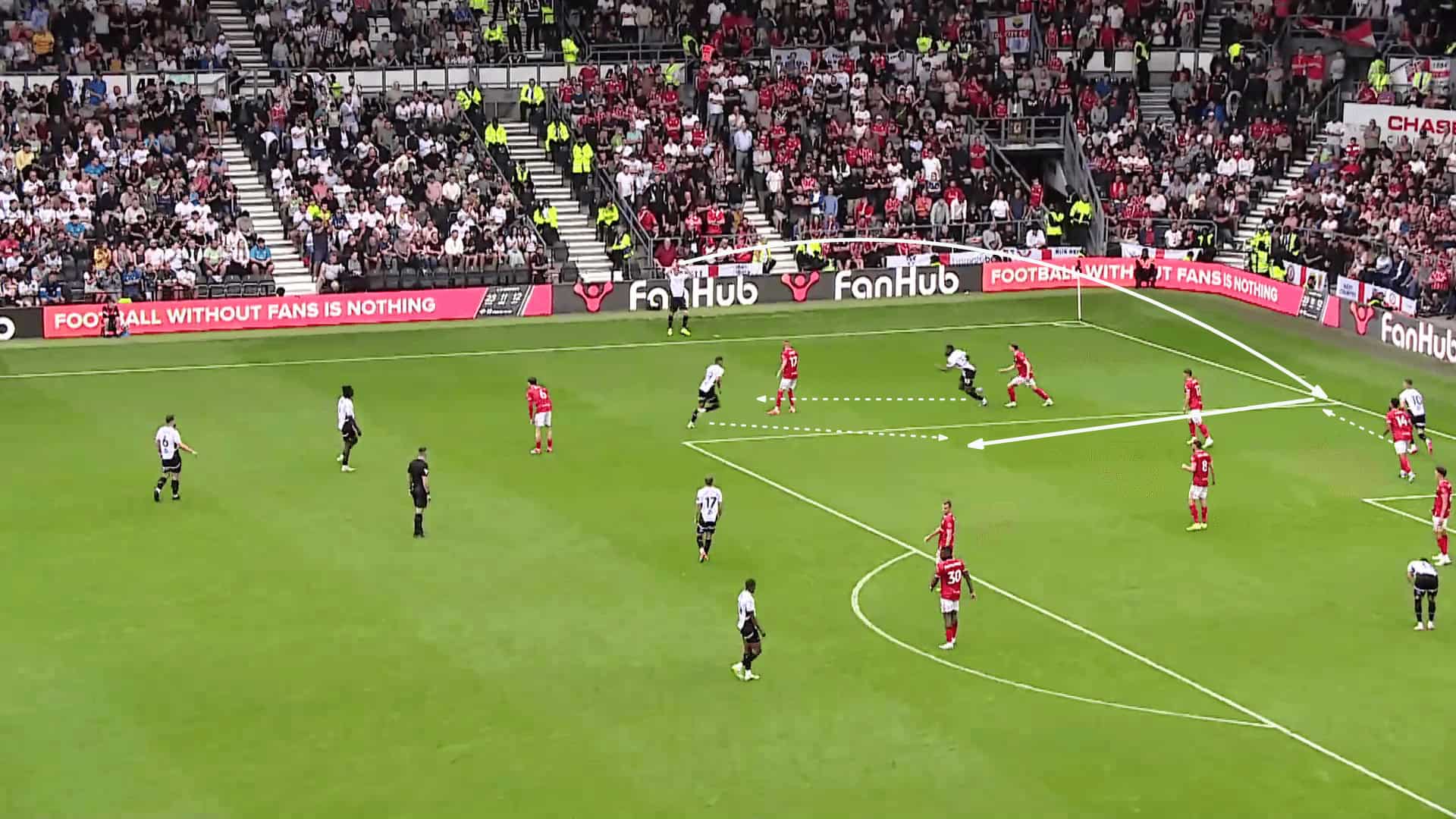
The plan works and ends with a goal from a near point to the goal.
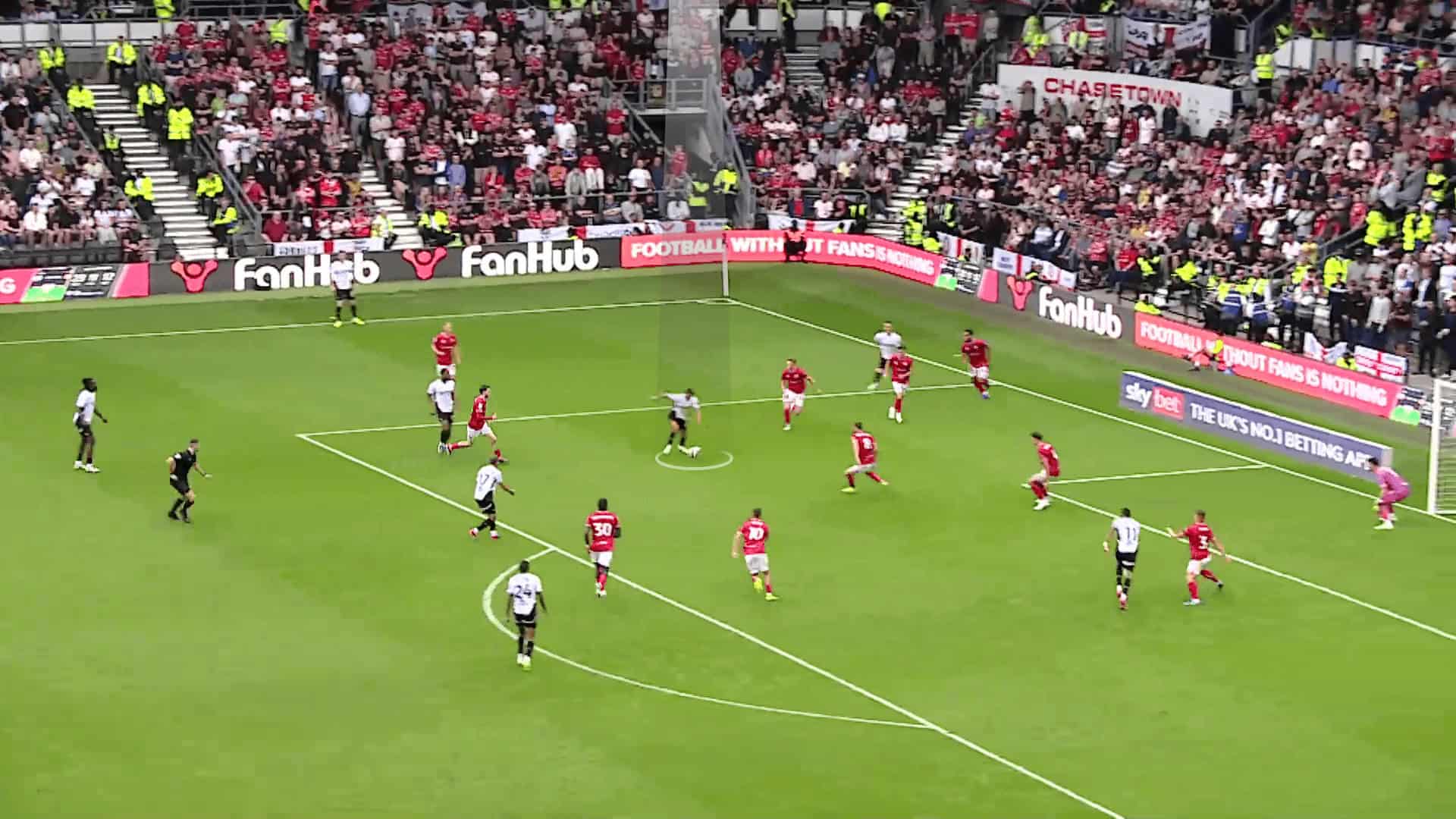
Conclusion
In this analysis, we have shown Derby County’s excellence in set-pieces, which may be a critical factor during the season.
In this set-piece analysis, we have explained how they use several types of pre-movements for different purposes to achieve success in both corners and throw-ins.






Comments